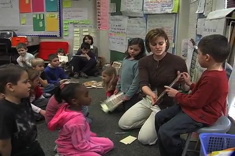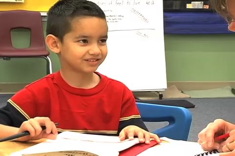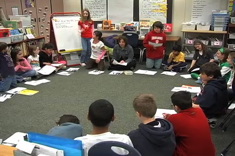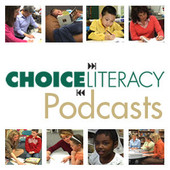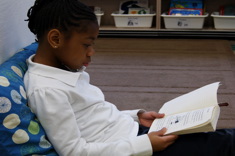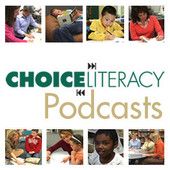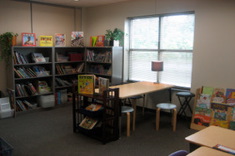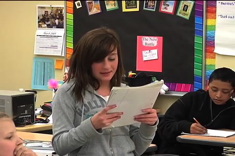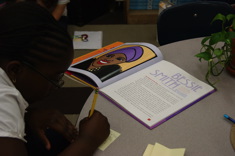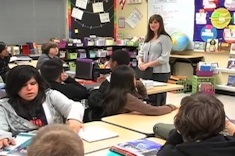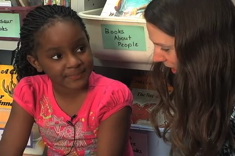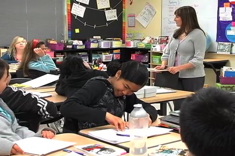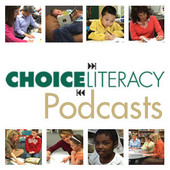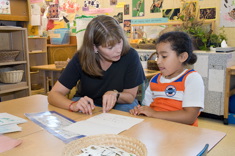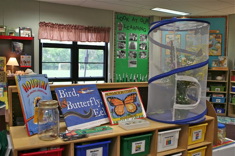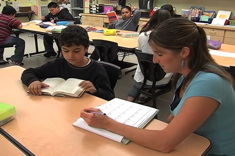Library
Choice Literacy Articles & Videos
The Choice Literacy library contains over 3,000 articles and 900 videos from 150+ contributors. Classic Classroom and Literacy Leadership subscribers have access to the entire library. Content is updated continuously, with five to six new features published each week.
Latest Content
Social Justice Picture Books
If you’re looking for a read aloud to spark some discussions about making a difference in the world, you might enjoy Ruth Shagoury’s new booklist of children’s literature with a social justice theme.
Purposeful First Grade Reading Share Sessions
Katie DiCesare prompts her 1st grade students during the reading share time at the end of workshop to make connections between the strategies they use during independent reading time and the day’s minilessons.
Drawing to Words: Conferring with Luis
In this four-minute video, Andie Cunningham confers with Luis during writing workshop. Luis is a six-year-old English language learner whose passion is drawing.
Read Alouds for the Last Days of School
Choice Literacy readers share some of their favorite read alouds for the last days of school.
Quick Take: Awkward Beginnings with English Language Learners
In this short video, Ruth Shagoury gives two pieces of advice to teachers who feel awkward as they are trying to communicate with young English language learners.
Book Matchmaker: Teaching Inferring to Intermediate Students
In this installment of Book Matchmaker, Franki Sibberson discusses the challenges of finding a range of books to teach the concept of inferring to grades 3-5 students.
Ann Marie Corgill on Launching Writer’s Workshop (PODCAST)
Ann Marie Corgill has advice for launching writer's workshop in this podcast.
Favorite Spaces (Part 1)
What's your favorite literacy spot this year in your classroom? We asked our friends and contributors at Choice Literacy to send in pictures with brief descriptions for this two-part feature. Here is a peek in the classrooms of Donalyn Miller, Julie Johnson, Mary Lee Hahn, Katie DiCesare, and Mandy Robek.
Quick and Thorough: Literacy Coach Conferring Notes
Jennifer Jones finds in a time of budget cuts it is more important than ever for literacy coaches to keep good records of how they spend their time with teachers. She shares a very simple spreadsheet system which includes content codes and brief notes.
Launching the Newbery Club
Bill Prosser and Maria Caplin continue their series on a Newbery Club for 5gth graders in their school. In this installment, they write about the launch of the club.
Books to Celebrate Earth Day
Earth Day in April is a great time to get outdoors with a good book! Franki Sibberson shares some of her favorite texts linked to Earth Day.
Book Matchmaker: Texts to Inspire Our Youngest Readers and Writers
In this installment of the Book Matchmaker series with Franki Sibberson, Franki helps first-grade teacher Danielle think through what books might spark better writing in her young students who are mostly interested in toys and video games.
Literacy Keepsakes to Carry Home at the End of the School Year
Choice Literacy readers share their favorite gifts for students to make and take home at the end of the year.
Make it Personal
The connections we make with students and families are what we remember most when all is said and done. Trish Prentice has thoughts on what changes a respected teacher into a beloved teacher.
A Congenial Parent Night
Invigorate your parent night with these suggestions from Trish Prentice.
Mary Lee Hahn – Read Alouds to Build Community Early in the Year (PODCAST)
Mary Lee Hahn shares her favorite read alouds for building community at the start of the year.
Favorite Spaces (Part 2)
We asked a few Choice Literacy contributors to share their favorite classroom spaces with readers. We hope you'll get some ideas for your own classroom design from these amazing teachers. This is the second installment in a two-part series.
Clearing Up Confusion
Katie Doherty works closely with a student who has an unusual request – he wants to take home a basal anthology for "pleasure reading." She puts a different text in his hands, and uses what she learns from the experience to design a for lesson her 6th grade students.
Young Learners and Martin Luther King Day (BOOKLIST)
Teachers of young learners face special challenges in honoring Martin Luther King and dealing with the violent nature of his death at the same time. Mandy Robek offers some insights into how to celebrate King's life with even the youngest students.
“I Am the One Who . . .” Building Writing Skills and Community in Middle Schools
In this 12-minute video, Katie Doherty leads her sixth-grade students as they try the prompt “I am the one who . . .” during writing workshop. This is an excellent activity for building classroom community.
Literacy Letters: Helping New Students Understand Ongoing Assignments
How do teachers bring new students up to speed with ongoing assignments? In this video from Katie Doherty’s middle school classroom, Katie presents the latest “Literary Letters” assignment to her 6th graders. It is early spring, and all but two of the students have experience with this writing assignment.
Getting Started with a Teacher Blog
Karen Terlecky shares practical tips for starting a teacher blog.
Injecting Writing into Everything: Prediction Stories
What happens between kindergarten and upper elementary grades to make students more hesitant about making predictions? Heather Rader has books and teaching suggestions for building prediction skills.
Seedfolks: Connecting Community and Literature
There's so much to do during the first weeks of school, but it's important not to skip the most important thing – building a sense of community with your students.
Jennifer Allen on Working with New Teachers (PODCAST)
New teachers need thoughtful support – Jennifer Allen has suggestions on how to provide that assistance in this podcast.
Creating a Coaching Schedule
Tammy Mulligan and Clare Ladrigan give advice on creating schedules for literacy coaches that integrate district goals and teacher interests.
34 Languages
What is the starting point for building community in a preschool classroom where almost every child speaks a different first language than their teacher? Melissa Kolb writes about how she gently guides her preschool students early in the year.
Undercover Coach: Making Time to Work with Children
If you're a literacy coach, the most important question to ask yourself may be this: How much time am I spending in classrooms? Shari Frost writes about how coaches can move beyond a quest for perfect demo lessons to a stance of co-learners with teachers.
Ready-to-Go Readers’ Theater Books
If you want to do more with readers’ theater to promote fluency, but can’t afford one of those expensive kits, you’ll enjoy this booklist. Shari Frost has compiled her favorite readers’ theater books with texts and illustrations students love.
Giving Up the Whole-Class Novel
When teachers shift to a reading workshop model, sometimes they struggle most with the move from whole-class novels to more individualized reading. Shari Frost has advice for helping teachers work through the transition, as well as ways to ensure students still have some shared reading experiences with their classmates.
Browse Content By
Type
Category
- Assessment Tools
- Big Fresh Archives
- Booklists
- Choice Numeracy
- Classroom Design
- Common Core
- Community Building
- Conferring
- Content Literacy
- Digital Literacy
- English Language Learners
- Equity
- Family Relations
- Free Samples
- Guiding Groups
- Leadership
- Literacy Coaches
- Mentor Texts
- Minilessons
- New Teacher Mentors
- Podcasts
- Poetry
- Quote Collections
- Reading Strategies
- Self Care
- Struggling and Striving Learners
- Talking and Listening
- Teacher Study Groups
- Teaching Reading
- Teaching Writing
- Word Study and Vocabulary
Author
- Melissa Quimby
- Nawal Qarooni
- Gwen Blumberg
- Julie Cox
- The Lead Learners
- Hannah Tills
- Josie Stewart
- Ruth Metcalfe
- Mallory Messenger
- Becca Burk
- Jodie Bailey
- Vivian Chen
- Mary Brower
- Tiffany Abbott Fuller
- Stephanie Affinito
- Ruth Ayres
- Leigh Anne Eck
- Heather Fisher
- Shari Frost
- Julie Johnson
- Suzy Kaback
- Gigi McAllister
- Shirl McPhillips
- Melanie Meehan
- Cathy Mere
- Debbie Miller
- Tara Barnett and Kate Mills
- Tammy Mulligan
- Dana Murphy
- Bitsy Parks
- David Pittman
- Brenda Power
- Heather Rader
- Matt Renwick
- Mandy Robek
- Christy Rush-Levine
- Gretchen Schroeder
- Jen Schwanke
- Brian Sepe
- Katherine Sokolowski
- Stella Villalba
- Jennifer Vincent
Grade Level
Choice Literacy Membership
Articles
Get full access to all Choice Literacy article content
Videos
Get full access to all Choice Literacy video content
Courses
Access Choice Literacy course curriculum and training


